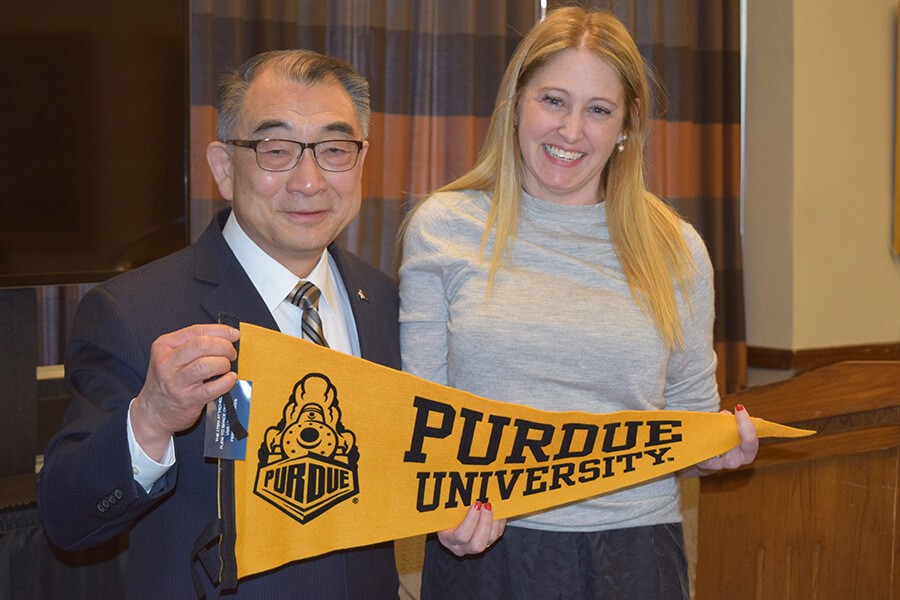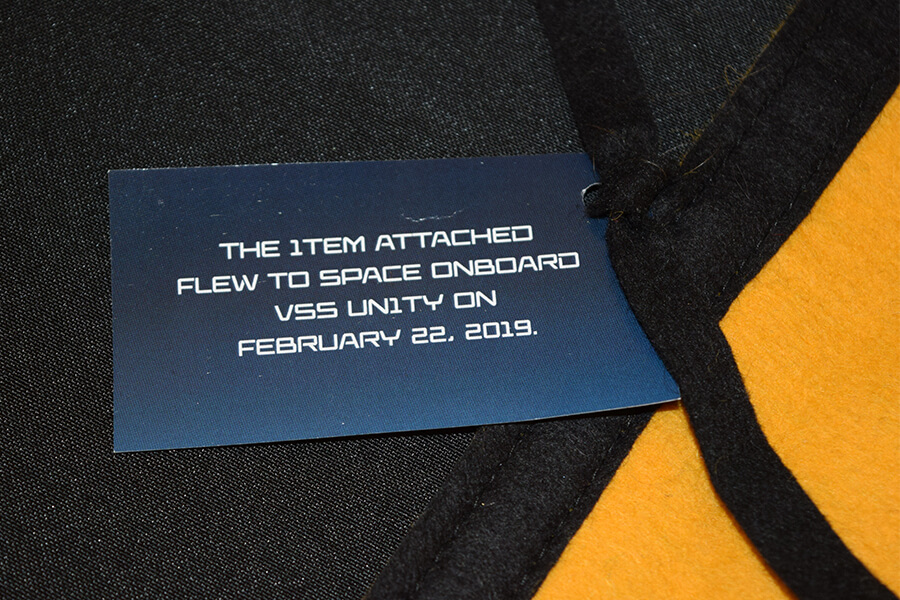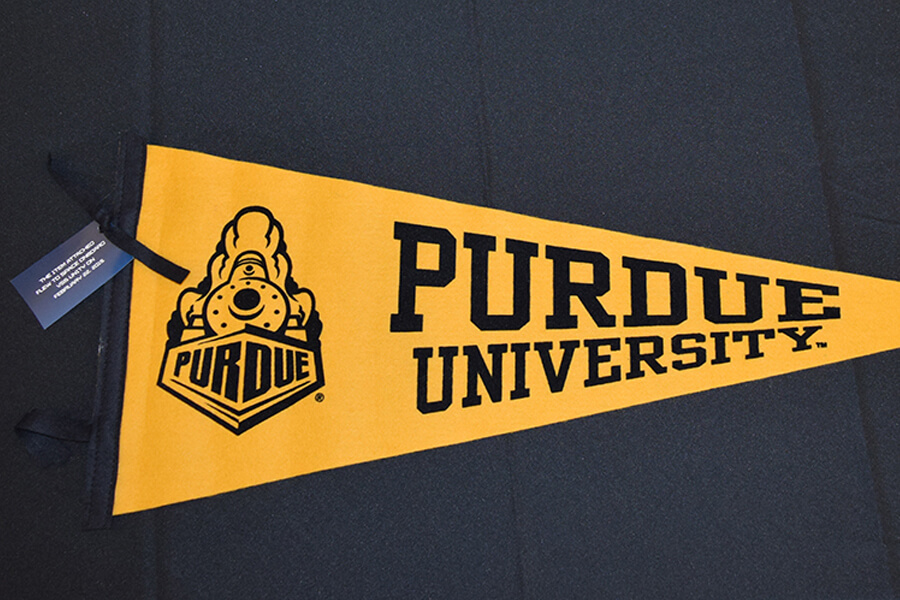Commercial astronaut alumna Moses gifts AAE pennant that flew to space
But Moses couldn’t tell Shih why she desperately wanted two Purdue items ASAP.
Few people knew in advance Moses was scheduled to be on the flight crew for the company’s second test flight on February 22, which meant she’d become the first woman to fly to space on a commercial vehicle. She wanted to make the trip even more memorable by representing the university she credits with launching her aerospace engineering career, first at NASA and now at Virgin Galactic.
So she sent the rush request to Shih. A staff member from the School of Aeronautics and Astronautics was dispatched and located a pair of pennants at University Bookstore, and they were shipped overnight.
Just in time for Moses to pack them on SpaceShipTwo for the suborbital flight.

“Purdue has such a space heritage and is so much a part of what I am, it just felt like something I wanted to honor,” Moses says. “I would not have been able to do that job and launch into my career if I didn’t have the education that Purdue gave me. I don’t think I would have been on that ship if Purdue hadn’t been in my background. So it just seemed like I needed to honor that legacy.”
But the idea wasn’t simply to fly pennants to space and keep them: Moses always planned on gifting them to Purdue.
Moses was able to follow through on that intention April 2 when she was back on campus to attend AAE’s Industrial Advisory Council meetings, a group of which she’s been a member since 2016. Just after a lunch break April 2, she gave a quick recap of the experience to the IAC and then presented Shih with a gold pennant. He’d told her to keep one for herself. So a black pennant will stay with Moses, who also wore her Purdue class ring on the flight.
The gifted gold pennant will be displayed inside Neil Armstrong Hall of Engineering.
“We’re so proud of Beth Moses’ accomplishments and grateful to her for sharing a piece of this exciting history with us,” Shih says. “For this event to happen at the 50th anniversary of the Apollo 11 Moon Landing makes it even more special since our alum, Neil Armstrong, is the first human to walk on the Moon, and Beth, also our alum, is the first female commercial astronaut. What a wonderful new entry to Purdue’s Cradle of Astronauts to begin a new age of space travel and exploration.”
The world learned Moses (BSAAE ’92, MSAAE ’94) was on board only moments after the flight took off. It didn’t take long for people to become enamored with her, especially once the photo was released of her reaction to seeing Earth — an open-mouthed moment of awe.
About eight weeks after the historic flight, Moses still can’t quite grasp the magnitude of the moment, the scope of its meaning.

Really, she was just doing her job as Galactic’s chief astronaut instructor, performing a cabin flight test to train future commercial customers. She had sensors strapped to her body to measure heart rate, vibration, and acceleration, among other things, and had 11 cameras focused on her. She had a timeline to keep, evaluating specific engineering tests. She unstrapped from the seat and floated around the cabin to evaluate that experience as well.
That other aspect, though, the “first” part? That’s proving a bit more elusive to grasp.
Moses never had any ambition to be first — she would have been happy to be “second or third or 10th or 5,000,000th” in space, she says. She wants everyone to have the opportunity to visit, and that’s what Virgin Galactic is working toward for its customers.
But now that she is the first? That only slowly is dawning on her, though she doesn’t plan on getting consumed by it. For now, she’s trying to stay grounded in what she knows: It was a successful test and an exhilarating experience.
“It’s the culmination of a personal lifelong ambition plus also the start of something phenomenal for humanity,” she says. “I feel both honored and humbled, and there’s a whole new era and whole new bit of exciting work to come. So it’s sort of like an anointment of the commercial space industry, as well as the beginning of an exciting time.”
There may be only one label Moses actually does care about.
Moses was enthralled with space as a kid, her bedroom covered in posters of the Space Shuttle. Nearby, her brother Chuck had posters of jets. Their mom jokes it was sibling rivalry — “Mine goes way faster than yours,” Beth would tell him — but Beth offers a firm “no” to that. Space always fascinated her.
It wasn’t until the first week of high school at Glenbrook North in the Chicago suburbs that she was able to identify her calling. She picked up a brochure in the science department that listed NASA astronauts. It showed their head shots and had short bios. At the bottom, there was a description of the astronaut corps, mentioning how there were pilots and researchers among the group and, also, aerospace engineers.
“As soon as I laid eyes on that phrase, I said, ‘Oh, that is what I want to be. I know that’s me,’” she says. “Of course, I always wanted to be an astronaut, who doesn’t? But I definitely wanted to engineer and fly spacecraft. I always was an aerospace engineer and hopeful astronaut.”
Then, she set a goal of attending Purdue and, then, working for NASA. Purdue certainly aided in the latter. During undergrad and graduate school at Purdue, Moses had nine co-op rotations with NASA’s Johnson Space Center in Houston. When she finished her master’s in AAE in 1994, NASA hired her.
Counting her co-op time, she was with NASA for 24 years, including as Space Station EVA System Manager. She worked on the ISS from drawing board to assembly complete. Once the ISS was finished, Moses (OAE ’18) joined the private sector with Virgin Galactic in 2013.
At Galactic, she’ll train professional staff to evaluate the cabin, just like she did on the recent flight. There will be more cabin tests for VSS Unity, but once all is verified and ready to go, she’ll start training Richard Branson and all the company’s customers. There are more than 600 ticketholders at this point.

Moses certainly will have a unique perspective to offer — and a shiny accoutrement on her flight suit when she does.
Galactic’s Feb. 22 flight climbed to a height of nearly 56 miles, which qualified Moses and the two pilots onboard for Commercial Astronaut Wings from the Federal Aviation Administration. She received those wings April 9 during a presentation at the Space Federation’s Space Symposium in Colorado Springs, Colorado.
The designation means Moses is Purdue’s 25th astronaut, 16 of whom are AAE graduates. She’s been invited — and plans to attend — Purdue’s astronaut reunion in October.
“That come-to-the-reunion invite was like, ‘Oh my god, I’m part of this group.’ That was a real moment,” she says. “I realized, ‘I’m not only an astronaut, I’m a Purdue astronaut.’ That means a lot. Those were my heroes. Those were my colleagues at NASA. I learned from that chain of people.”
Source: Commercial astronaut alumna Moses gifts AAE pennant that flew to space
